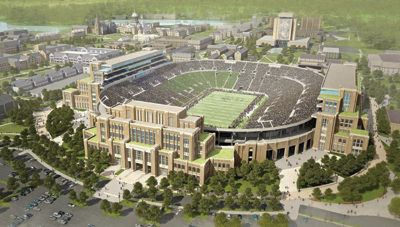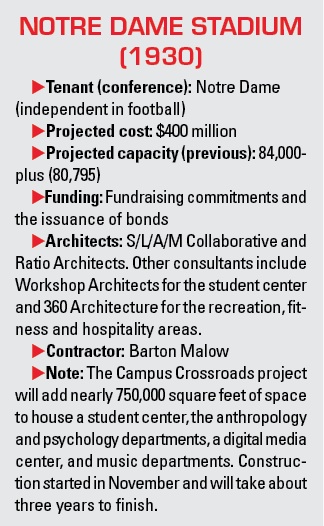The $400 million facelift of historic Notre Dame Stadium “has everything to do with geography and not much to do with football,” according to Jack Swarbrick, the university’s athletic director.
The “House that Knute Rockne Built” opened in 1930 off campus. Over the years, as the school expanded its reach in South Bend, the stadium settled into the heart of campus and became a centerpiece for the Notre Dame experience and its many storied traditions.
As a result, almost 90 years after Notre Dame Stadium opened, university leaders prefer to keep it intact compared with other schools that felt it was necessary to build stadiums farther from their inner core.
 |
Classroom and recreational space is being added to the stadium’s exterior.
Photo by: Notre Dame |
“I grew up in Bloomington, Ind., and it happened there [at Indiana University],” Swarbrick said. “Campus grew up around the stadium, they tore down the stadium and built it further off campus, and that’s generally what universities have done.”
But due to the historical significance of Notre Dame Stadium, at a school that has won 11 national championships competing as an independent, building a new facility elsewhere was not an option, Swarbrick said. School officials instead focused on upgrading the 80,795-seat building.
The stadium underwent a $50 million expansion that added 21,000 seats in the late 1990s. This time, though, as officials studied the stadium’s long-term future on property that Swarbrick said is the most valuable real estate on campus, they took a different tack. For the university, the issue became how the stadium could be redeveloped into a year-round facility used by all Notre Dame students, and not just the football team playing six to seven home games a year.
The resolution was to fold permanent classroom, recreational and new technology space into the stadium.
“Our focus became the other 359 days a year and that’s where the idea of connecting academic buildings to it and student life buildings to it took shape,” Swarbrick said. “We were way down the road before we talked about any of the football consequences. It was the notion of taking the departments of psychology, anthropology and music, the student rec center, student career services and a digital media hub, and putting all of that on this valuable real estate that just happened to be where the football stadium was. That’s really what our project was about.”
Building new facilities for those academic and recreational programs were all needs that had been identified as part
of the university’s strategic plan before officials came up with the cost-efficient idea to fold them into the stadium renovations.
The question became, “Do we build a separate psych building or is this a good solution for it?” Swarbrick said.
“The same with music, anthropology and career services. They were all things on the radar to be done.”
Swarbrick couldn’t put a number on the total cost to build all of those facilities individually “but you’re talking about at least six separate buildings, so there’s a real efficiency here and approach by combining those at the stadium,” he said.
“We think it’s unique to have truly independent functions that relate to academics and have nothing to do with athletics.”
Said Earl Santee, Populous’ principal-in-charge of the $450 million renovation of Texas A&M’s Kyle Field: “When you’re in the middle of campus, I think there has to be a multi-use purpose to these facilities. It’s not just about the football stadium and the game-day experience.”
Make no mistake, though, the football piece of the equation is paying the freight for funding Campus Crossroads, the project’s official title.
A team of architects including 360 Architecture, Notre Dame’s sports consultant, is designing 3,000 to 4,000 new club seats and loge boxes, and the marketing and fundraising tied to those premium products serve as the primary funding mechanisms for the project.
Unlike other schools that use television money to help pay for facility development, Notre Dame will not tap into the revenue it receives through its deal with NBC Sports Group, Swarbrick said. The school uses those millions of dollars to fund its financial aid program for general students.
The new high-end seating inventory marks a first for premium seats at Notre Dame Stadium. Joyce Center, the school’s basketball arena, and the Compton Family Ice Arena both have club seats, and the school is following the same model for football, Swarbrick said.
Luxury suites are not part of the stadium renovation because officials feel the skybox concept does not fit with the culture at Notre Dame that strongly believes in a shared game-day experience.
“We don’t want people isolated in certain places,” Swarbrick said. “It’s about interaction, it’s about the Notre Dame community, and we want to have a seating model that reflects that.”
The multiyear project broke ground in late November and is expected to be completed for the 2017 season.
Swarbrick foresees an upgraded facility that will remain sustainable for as long as Notre Dame plays football.
“We’ve resealed the seating bowl and invested a lot just trying to preserve the historical assets, and as long as we continue to do that, and I’m comfortable that we will, I don’t think there’s any end date to this,” Swarbrick said.





